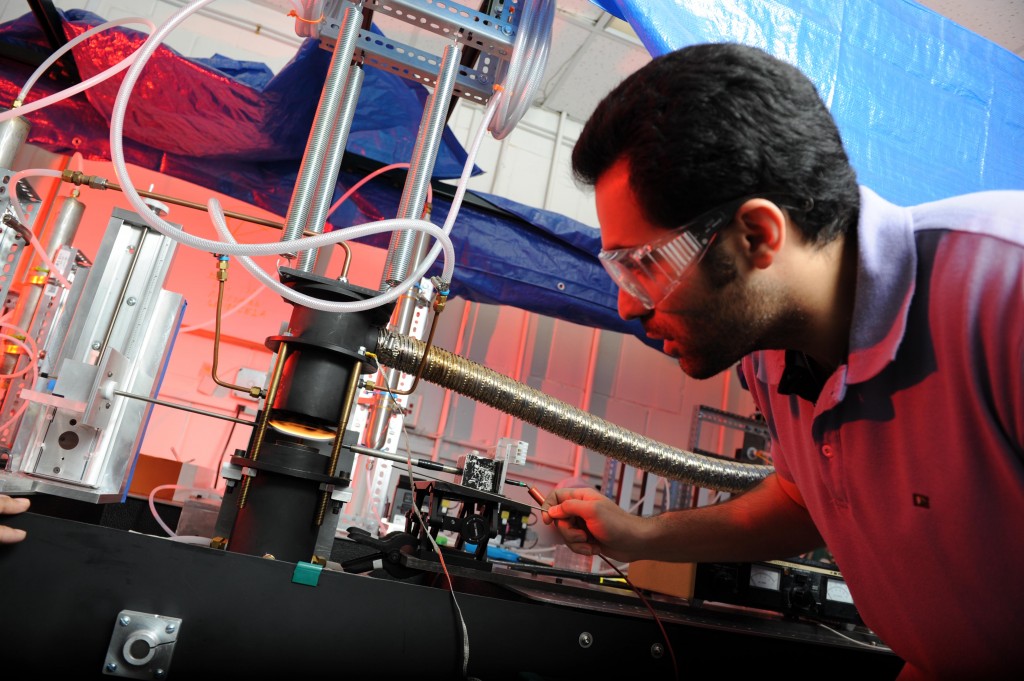Nanomaterials are necessities of modern life. They can be strong, firm and ductile at high temperatures. They are wear-, erosion-, and corrosion-resistant, and are chemically active. They make planes simultaneously lighter and stronger, roofs more weather resistant, and they have applications in fields as diverse as medicine and clean energy.
Transition metal oxides are particularly in-demand nanomaterials. Engineers design these microscopic materials to contain specific electronic and mechanical properties. TMOs designed with cavities and platelets can be filled with liquid or nanomaterials. TMOs with microscopic rods and wires provide increased stability.
TMOs have
the potential to become the building blocks of our modern world.
Increased demand has highlighted a flaw in the creation of TMOs. The current growth process, Chemical Vapor Deposition, is a tedious, multi-step batch process that can take from a few hours to a few days to complete. Time, expense and the subsequent low supply have made TMOs impractical on a large scale.
But a faculty member at the University of Oklahoma School of Aerospace and Mechanical Engineering has discovered how to create TMOs faster.

Moien Farmahini, a Ph.D. candidate in mechanical engineering, runs experiments with Merchán-Merchán in the lab on the University of Oklahoma Norman campus.
Turning Up the Heat
AME associate professor of mechanical engineering Wilson Merchán-Merchán did not set out to discover a new process for synthesizing TMOs.
After previous success using an oxygen-enriched flame to synthesize common nanomaterials like carbon nanotubes, he and his team decided to try using the same method to create a new form of carbon structure. Instead of synthesizing the nanomaterials they sought to grow, they stumbled upon a new method of creating unique 1-D and 3-D TMOs.
The development of the high-rate synthesis method of TMOs is a game changer in nanomaterials research. It will fuel new applications and create a demand for large volumes of these nanomaterials.
Funded by generous multi-year grants from the National Science Foundation, Merchán-Merchán and his research affiliates at OU, as well as Alexei Saveliev, Ph.D., at North Carolina State University, expose bulk transition metals to the hottest parts of an oxygen-enriched flame. From that reaction, they instantaneously synthesize high-demand transition metal-oxides.
In this single-step process, Merchán-Merchán is doing in seconds what had taken days.
New Method Means More Applications
Inexpensive and quick growth of TMOs means a better chance for large-scale synthesis and eventual common use in the marketplace. The potential for increased supply led to increased experimentation on the capacity of TMOs. The results are staggering in both their effectiveness and their diverse range of applications.
“Recently, one-dimensional TMO naonostructures have attracted tremendous attention due to their applications in optics, medicine and electrons,” Merchán-Merchán explained. “For instance, channel structures contain slender, prismatic and completely hollow cavities, and can be used in medical applications for drug delivery.”
Recently, Merchán-Merchán and his team coated the surface of solar panels with flame synthesized W-oxide nanorods. The result was a 5-percent increase in the solar panel’s efficiency, a large gain, considering solar panels’ notoriously low-efficiency rating of 15 to 20 percent.
With endless applications and a new horizon of possibilities, Merchán-Merchán’s research into TMOs is still in its infancy.
Fanning the Flame
Merchán-Merchán’s research has put him on the map and may change the way everything from solar panels to medicines and airplanes are designed. But he also has worked diligently to be an excellent teacher.
Merchán-Merchán decided to become a professor during his junior year of college. Alexander Fridman, his thermodynamics professor, allowed him to work on a plasma project.
“That’s when I fell in love with research,” he said.
Opportunities to work with students as a graduate teaching assistant showed him he could have the best of both worlds as a professor – he could research and teach.
Merchán-Merchán works closely with graduate students in his research laboratory. Every semester he provides research opportunities to a small number of undergraduate students though OU’s Undergraduate Research and Guided Individual Studies course. He also involves a select group of local high school students in research projects in the summer and after school. Some of his students are supported to conduct research through National Science Foundation awards.
Merchán-Merchán sees his efforts as a way to encourage top students to pursue an engineering career.
“Recent studies have suggested that student-faculty interactions outside the classroom can be an important factor in a student’s decision to enroll in an advanced science and engineering program as well as to prepare them for successful careers in industry,” Merchán-Merchán explained.
Merchán-Merchán’s research will have profound implications for the future, as products equipped with TMOs eventually become commonplace in the marketplace. His passion for teaching will also reach far into the future. Whether Merchán-Merchán’s students go on to become engineers or professors or even if they venture into entirely different fields, just like the products enhanced by TMOs, they will be strengthened.
